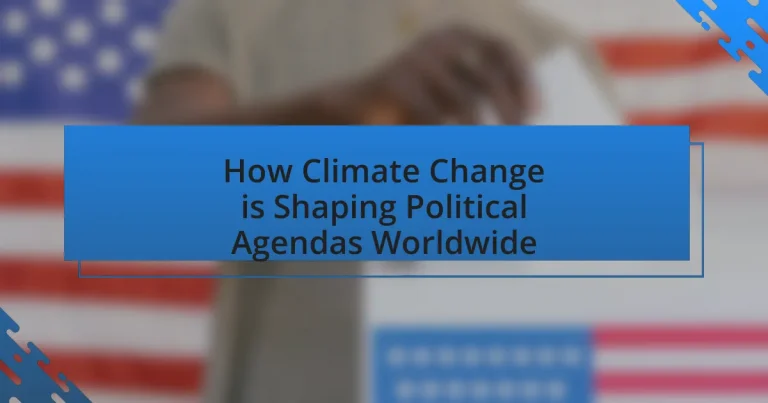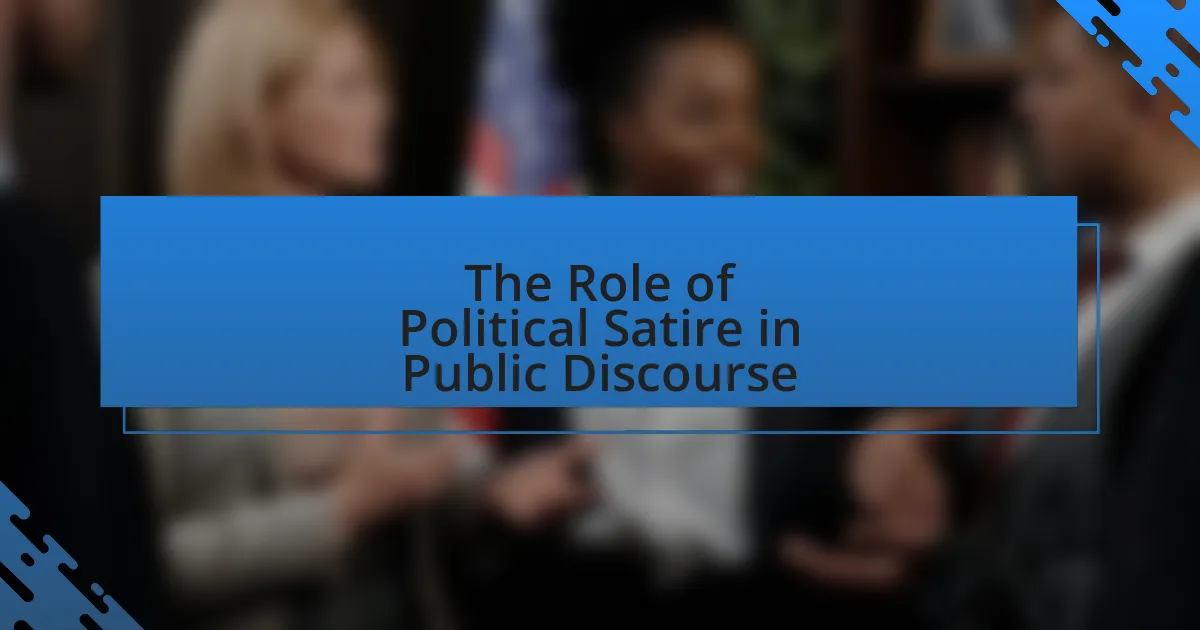Climate change is increasingly influencing political agendas worldwide, compelling governments to prioritize environmental policies and sustainability initiatives. The article examines how climate-related issues are integrated into national and international frameworks, highlighting key political responses such as the Paris Agreement and various national legislations. It discusses the varying approaches different countries take based on their economic status and environmental vulnerabilities, as well as the role of international agreements in shaping domestic policies. Additionally, the article explores the impact of public opinion, grassroots movements, and local government actions on climate policy, while addressing the economic implications and future challenges posed by climate change on global political dynamics.
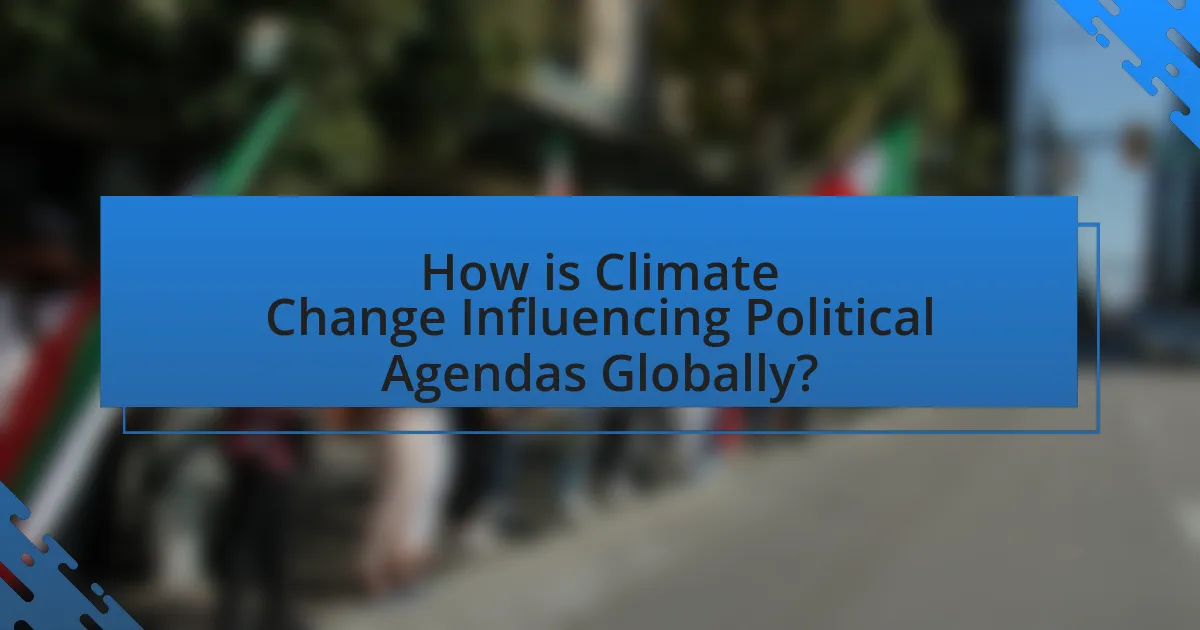
How is Climate Change Influencing Political Agendas Globally?
Climate change is significantly influencing political agendas globally by prompting governments to prioritize environmental policies and sustainability initiatives. As extreme weather events and rising sea levels become more frequent, political leaders are increasingly pressured to address climate-related issues, leading to the incorporation of climate action into national and international policy frameworks. For instance, the Paris Agreement, adopted in 2015, exemplifies a global commitment to limit temperature rise and reduce greenhouse gas emissions, reflecting a shift in political priorities towards climate resilience. Additionally, public demand for climate action has surged, with movements like Fridays for Future mobilizing millions, thereby compelling politicians to align their agendas with the expectations of their constituents. This shift is evident in the growing number of countries implementing carbon pricing, renewable energy incentives, and climate adaptation strategies, demonstrating that climate change is reshaping political landscapes worldwide.
What are the key political responses to climate change?
Key political responses to climate change include the implementation of international agreements, national legislation, and local initiatives aimed at reducing greenhouse gas emissions and promoting sustainability. For instance, the Paris Agreement, adopted in 2015, represents a global commitment where countries set targets to limit global warming to well below 2 degrees Celsius. Additionally, many nations have enacted laws such as the Green New Deal in the United States, which aims to address climate change through economic reform and investment in renewable energy. Local governments also play a crucial role by adopting policies that promote public transportation, energy efficiency, and conservation efforts. These responses are supported by scientific consensus on climate change impacts, as highlighted in reports from the Intergovernmental Panel on Climate Change, which emphasize the urgent need for coordinated political action.
How do different countries prioritize climate change in their policies?
Different countries prioritize climate change in their policies through varying approaches, influenced by their economic status, environmental vulnerabilities, and political will. For instance, the European Union has implemented the European Green Deal, aiming for carbon neutrality by 2050, which reflects a strong commitment to climate action. In contrast, the United States has fluctuated in its climate policy focus, with the Biden administration rejoining the Paris Agreement and setting ambitious targets for emissions reduction, while previous administrations had deprioritized such commitments. Developing nations often prioritize climate change adaptation strategies due to their heightened vulnerability to climate impacts, as seen in countries like Bangladesh, which has integrated climate resilience into its national development plans. These examples illustrate how national priorities regarding climate change are shaped by a combination of economic capabilities, political leadership, and specific environmental challenges.
What role do international agreements play in shaping political agendas?
International agreements play a crucial role in shaping political agendas by establishing binding commitments and frameworks for cooperation among nations. These agreements, such as the Paris Agreement, set specific targets for greenhouse gas emissions reductions, compelling countries to align their domestic policies with international climate goals. For instance, the Paris Agreement, adopted in 2015, has led to significant shifts in national policies, as countries are required to submit nationally determined contributions (NDCs) that reflect their climate ambitions. This process encourages governments to prioritize climate action in their political agendas, influencing legislation, funding allocations, and international relations.
Why is climate change a critical issue for political leaders?
Climate change is a critical issue for political leaders because it poses significant risks to public health, economic stability, and national security. Political leaders must address climate change to mitigate its impacts, as extreme weather events, rising sea levels, and food insecurity threaten communities globally. For instance, the Intergovernmental Panel on Climate Change (IPCC) reports that without immediate action, global temperatures could rise by 1.5 degrees Celsius above pre-industrial levels by 2030, leading to catastrophic consequences. This urgency compels political leaders to integrate climate policies into their agendas to ensure sustainable development and protect future generations.
How does public opinion on climate change affect political decisions?
Public opinion on climate change significantly influences political decisions by shaping policymakers’ priorities and legislative actions. When a substantial portion of the electorate expresses concern about climate change, politicians are more likely to advocate for environmental policies to align with public sentiment and secure votes. For instance, a 2021 Pew Research Center survey indicated that 70% of Americans view climate change as a major threat, prompting many elected officials to support initiatives like renewable energy investments and emissions reduction targets. This correlation between public concern and political action demonstrates how voter preferences can drive legislative agendas focused on climate change.
What are the economic implications of climate change for governments?
Climate change has significant economic implications for governments, primarily through increased costs related to disaster response, infrastructure adaptation, and public health. Governments face rising expenditures due to more frequent and severe weather events, which can lead to substantial damage to property and infrastructure. For instance, the National Oceanic and Atmospheric Administration reported that the U.S. experienced 22 separate billion-dollar weather and climate disasters in 2020 alone, highlighting the financial burden on government resources.
Additionally, governments must invest in climate resilience measures, such as upgrading infrastructure to withstand extreme weather, which can strain budgets. The Global Commission on Adaptation estimates that investing $1.8 trillion in climate adaptation could yield $7.1 trillion in economic benefits by 2030, indicating that proactive measures can mitigate long-term costs.
Furthermore, climate change impacts public health, leading to increased healthcare costs due to heat-related illnesses, respiratory issues from poor air quality, and vector-borne diseases. The World Health Organization projects that climate change could cause an additional 250,000 deaths per year between 2030 and 2050, further straining government healthcare systems and budgets.
In summary, the economic implications of climate change for governments include increased disaster response costs, the need for infrastructure investment, and rising public health expenditures, all of which can significantly impact national budgets and economic stability.
How are political parties adapting their platforms to address climate change?
Political parties are adapting their platforms to address climate change by incorporating ambitious climate policies, committing to net-zero emissions targets, and promoting renewable energy initiatives. For instance, many parties are now advocating for legislation that aims to reduce carbon emissions by specific percentages by 2030, reflecting a growing recognition of the urgency of climate action. In the United States, the Democratic Party’s platform includes a commitment to achieving net-zero emissions by 2050, while the Green Party emphasizes a rapid transition to 100% renewable energy by 2030. These adaptations are often supported by scientific consensus, such as the Intergovernmental Panel on Climate Change’s reports, which highlight the need for immediate action to mitigate climate impacts.
What differences exist between political parties regarding climate policies?
Political parties differ significantly in their climate policies, primarily in their approaches to regulation, investment in renewable energy, and commitment to international agreements. For instance, progressive parties often advocate for aggressive climate action, including comprehensive regulations on emissions and substantial investments in green technologies, as seen in the Green New Deal proposed by the Democratic Party in the United States. In contrast, conservative parties may prioritize economic growth over stringent climate regulations, focusing instead on market-driven solutions and energy independence, as exemplified by the Republican Party’s support for fossil fuel industries. Additionally, some parties may express skepticism about climate change, leading to minimal policy initiatives, which is evident in certain right-wing parties in Europe. These differences reflect broader ideological divides regarding the role of government in addressing environmental issues and the urgency of climate action.
How do grassroots movements influence party agendas on climate change?
Grassroots movements significantly influence party agendas on climate change by mobilizing public support and raising awareness about environmental issues. These movements often engage in advocacy, organizing protests, and utilizing social media to amplify their messages, which can pressure political parties to adopt more ambitious climate policies. For instance, the global youth-led climate strikes initiated by movements like Fridays for Future have prompted political leaders to prioritize climate action in their platforms, as seen in the increased focus on climate policies in the 2020 U.S. presidential election. Research indicates that when grassroots movements gain traction, they can shift public opinion and compel parties to align their agendas with the demands of their constituents, thereby making climate change a central issue in political discourse.
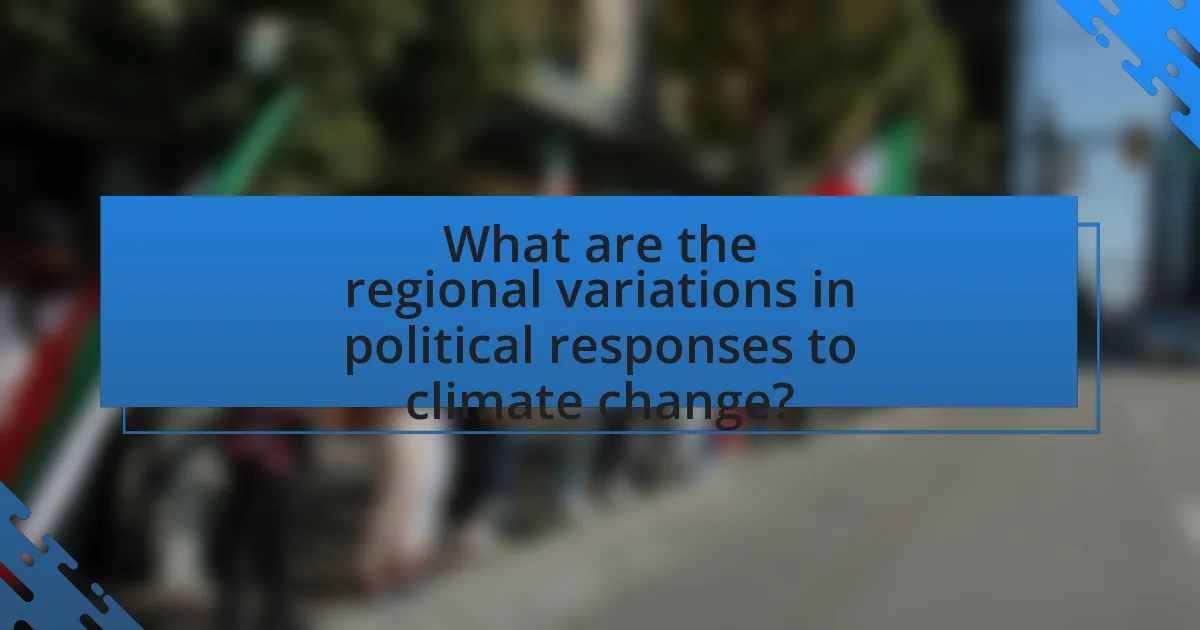
What are the regional variations in political responses to climate change?
Political responses to climate change vary significantly across regions due to differing economic priorities, environmental vulnerabilities, and social contexts. For instance, European countries often implement stringent climate policies, such as the European Green Deal, aiming for carbon neutrality by 2050, reflecting a strong public consensus on climate action. In contrast, the United States exhibits a more fragmented approach, with state-level initiatives like California’s cap-and-trade system contrasting with federal policies that may prioritize economic growth over environmental regulations.
In developing regions, such as parts of Africa and Southeast Asia, political responses are often influenced by immediate socio-economic challenges, leading to a focus on adaptation strategies rather than mitigation. For example, countries like Bangladesh prioritize disaster resilience and adaptation funding due to their high vulnerability to climate impacts, such as flooding and cyclones.
These regional variations underscore how local contexts shape political agendas, with wealthier nations generally able to invest more in comprehensive climate strategies, while poorer nations often grapple with balancing development needs and climate resilience.
How do developed countries approach climate change differently than developing countries?
Developed countries typically approach climate change with more resources and established frameworks for mitigation and adaptation compared to developing countries. For instance, developed nations often have the financial capacity to invest in renewable energy technologies, implement stringent environmental regulations, and participate in international agreements like the Paris Accord, which aims to limit global warming. In contrast, developing countries frequently face economic constraints that limit their ability to invest in such initiatives, leading them to prioritize immediate economic growth and poverty alleviation over long-term climate strategies. According to the World Bank, developed countries contribute approximately 70% of global greenhouse gas emissions, while developing countries, despite their lower per capita emissions, are often more vulnerable to the impacts of climate change due to limited infrastructure and resources.
What challenges do developing nations face in implementing climate policies?
Developing nations face significant challenges in implementing climate policies, primarily due to limited financial resources, inadequate technological infrastructure, and competing developmental priorities. Financial constraints hinder their ability to invest in renewable energy and sustainable practices, as evidenced by the fact that many developing countries require an estimated $2.4 trillion annually to meet their climate goals, according to the United Nations Environment Programme. Additionally, the lack of access to advanced technologies restricts their capacity to adopt efficient energy solutions and mitigate emissions effectively. Competing developmental priorities, such as poverty alleviation and economic growth, often take precedence over climate initiatives, leading to a lack of political will and commitment to enforce climate policies.
How do economic resources impact climate change strategies in different regions?
Economic resources significantly influence climate change strategies across different regions by determining the capacity for investment in sustainable technologies and infrastructure. Regions with abundant economic resources, such as developed countries, can allocate substantial funding towards renewable energy projects, advanced research, and climate adaptation measures, leading to more effective and comprehensive climate strategies. For instance, the European Union has committed over €1 trillion to green initiatives as part of its Green Deal, showcasing how financial capability can drive ambitious climate action. Conversely, regions with limited economic resources, such as many developing countries, often struggle to implement effective climate strategies due to financial constraints, relying heavily on international aid and technology transfer to address climate challenges. This disparity in economic resources creates a significant gap in the effectiveness of climate change strategies globally, as evidenced by the varying levels of emissions reductions and adaptation efforts observed in different regions.
What role do local governments play in addressing climate change?
Local governments play a crucial role in addressing climate change by implementing policies and initiatives that reduce greenhouse gas emissions and promote sustainability. They are responsible for land use planning, waste management, and energy efficiency programs, which directly impact local carbon footprints. For instance, cities like San Francisco have adopted ambitious climate action plans that aim for significant reductions in emissions by 2030, demonstrating the effectiveness of localized strategies. Additionally, local governments often engage communities in climate resilience efforts, such as developing green infrastructure and enhancing public transportation, which further supports climate adaptation and mitigation.
How can cities lead the way in climate action initiatives?
Cities can lead the way in climate action initiatives by implementing comprehensive sustainability policies and fostering community engagement. For instance, cities like Copenhagen have committed to becoming carbon neutral by 2025 through investments in renewable energy and public transportation. This commitment is supported by the fact that urban areas contribute approximately 70% of global greenhouse gas emissions, making them critical players in climate mitigation efforts. By prioritizing green infrastructure, promoting energy efficiency, and encouraging local participation, cities can effectively drive significant climate action and influence broader political agendas.
What are some successful local policies that have emerged in response to climate change?
Successful local policies that have emerged in response to climate change include urban green space initiatives, renewable energy mandates, and comprehensive waste management programs. For instance, cities like New York have implemented the “OneNYC” plan, which aims to reduce greenhouse gas emissions by 80% by 2050 through various sustainability measures. Additionally, San Francisco’s mandatory composting and recycling laws have significantly reduced landfill waste, achieving a diversion rate of over 80%. These policies demonstrate effective local governance in addressing climate change through actionable and measurable strategies.
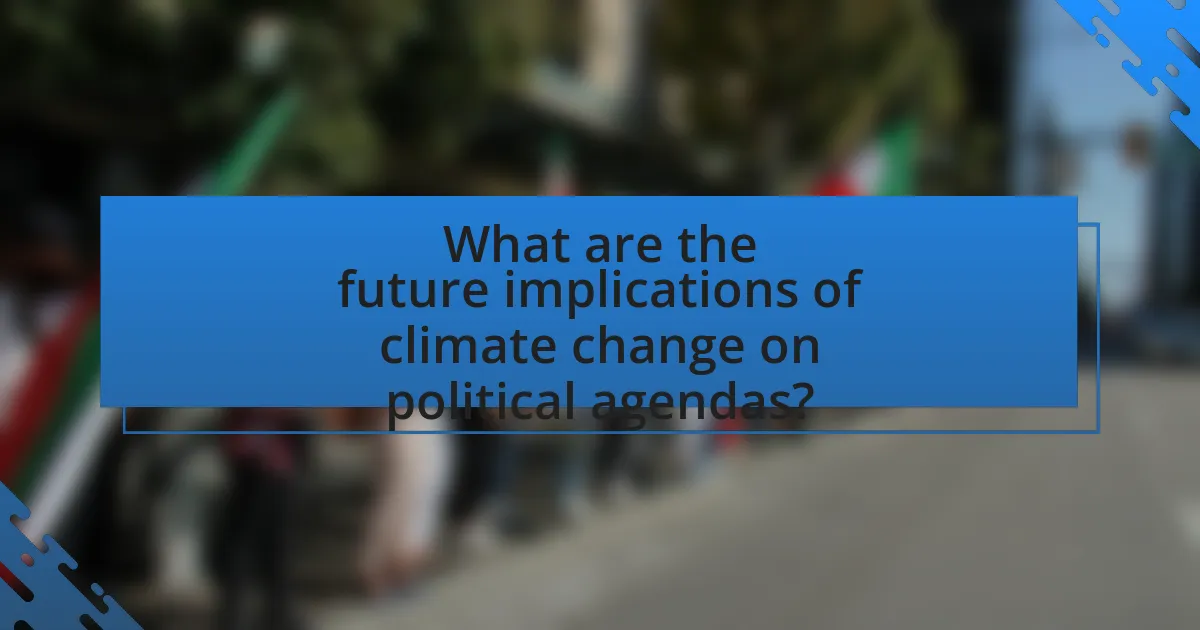
What are the future implications of climate change on political agendas?
Climate change will increasingly drive political agendas towards sustainability and environmental policies. As global temperatures rise and extreme weather events become more frequent, governments will prioritize climate action to mitigate impacts on public health, economies, and national security. For instance, the 2021 United Nations Climate Change Conference (COP26) highlighted commitments from countries to reduce carbon emissions, reflecting a shift in political focus towards green energy and climate resilience. This trend is supported by public demand for action, as surveys indicate that a significant majority of citizens view climate change as a critical issue requiring immediate government intervention.
How might climate change reshape global power dynamics?
Climate change may significantly reshape global power dynamics by altering resource availability and geopolitical relationships. As climate change leads to increased scarcity of essential resources like water and arable land, nations that can adapt and manage these resources effectively may gain strategic advantages. For instance, the melting Arctic ice is opening new shipping routes and access to untapped natural resources, which could shift economic power towards Arctic nations such as Russia and Canada. Additionally, countries that invest in renewable energy technologies may enhance their energy security and economic resilience, further influencing global power structures. Historical examples, such as the Arab Spring, illustrate how resource scarcity can lead to political instability, suggesting that climate-induced challenges could similarly destabilize regions and alter alliances.
What potential conflicts could arise from climate-related resource scarcity?
Climate-related resource scarcity can lead to conflicts over water, food, and energy resources. As climate change exacerbates droughts and alters precipitation patterns, competition for dwindling freshwater supplies can intensify, particularly in regions already facing water stress, such as the Middle East and North Africa. Additionally, agricultural productivity may decline due to changing climate conditions, leading to food shortages and increased prices, which can spark civil unrest and conflict, as seen in the Arab Spring where rising food costs contributed to social upheaval. Furthermore, energy resource conflicts may arise as nations vie for access to renewable energy sources and fossil fuels, particularly in geopolitically sensitive areas. Historical examples, such as the Darfur conflict, illustrate how resource scarcity can escalate into violence, highlighting the urgent need for effective governance and international cooperation to mitigate these risks.
How can nations collaborate to mitigate the effects of climate change?
Nations can collaborate to mitigate the effects of climate change by establishing international agreements, sharing technology, and funding climate adaptation projects. For instance, the Paris Agreement, adopted in 2015, exemplifies a global framework where countries commit to reducing greenhouse gas emissions and enhancing climate resilience. Additionally, nations can engage in joint research initiatives to develop sustainable technologies, such as renewable energy sources, which can be shared across borders. Financial mechanisms, like the Green Climate Fund, enable wealthier nations to support developing countries in their climate efforts, ensuring a collective approach to addressing climate challenges. These collaborative efforts are essential for achieving significant reductions in global emissions and fostering sustainable development.
What strategies can political leaders adopt to effectively address climate change?
Political leaders can adopt strategies such as implementing comprehensive climate policies, investing in renewable energy, and promoting international cooperation to effectively address climate change. Comprehensive climate policies, like the Green New Deal in the United States, aim to reduce greenhouse gas emissions while creating jobs and stimulating the economy. Investing in renewable energy sources, which accounted for 29% of global electricity generation in 2020, can significantly decrease reliance on fossil fuels. Additionally, promoting international cooperation through agreements like the Paris Agreement, which aims to limit global warming to well below 2 degrees Celsius, fosters collective action among nations to combat climate change. These strategies are essential for creating a sustainable future and mitigating the impacts of climate change.
What best practices can be implemented to enhance climate policy effectiveness?
To enhance climate policy effectiveness, governments should implement evidence-based decision-making, stakeholder engagement, and adaptive management strategies. Evidence-based decision-making ensures that policies are grounded in scientific research and data, which increases their credibility and effectiveness. For instance, the Intergovernmental Panel on Climate Change (IPCC) provides comprehensive assessments that inform policy frameworks globally. Stakeholder engagement involves including diverse voices, such as local communities and businesses, in the policy-making process, which fosters broader support and compliance. Adaptive management allows policies to be flexible and responsive to new information and changing conditions, as demonstrated by the success of the California cap-and-trade program, which adjusts based on emissions data. These practices collectively contribute to more robust and effective climate policies.
How can political leaders engage citizens in climate action initiatives?
Political leaders can engage citizens in climate action initiatives by implementing inclusive policies that encourage public participation and awareness. For instance, leaders can organize community forums and workshops to educate citizens about climate issues and gather their input on local environmental policies. Research indicates that participatory governance enhances citizen engagement, as seen in the 2019 Global Climate Action Summit, where local governments involved citizens in decision-making processes, leading to increased public support for climate initiatives. Additionally, leveraging social media platforms allows leaders to disseminate information rapidly and mobilize grassroots movements, further fostering community involvement in climate action.
